Bin Qin
IMSE: Efficient U-Net-based Speech Enhancement using Inception Depthwise Convolution and Amplitude-Aware Linear Attention
Nov 18, 2025Abstract:Achieving a balance between lightweight design and high performance remains a significant challenge for speech enhancement (SE) tasks on resource-constrained devices. Existing state-of-the-art methods, such as MUSE, have established a strong baseline with only 0.51M parameters by introducing a Multi-path Enhanced Taylor (MET) transformer and Deformable Embedding (DE). However, an in-depth analysis reveals that MUSE still suffers from efficiency bottlenecks: the MET module relies on a complex "approximate-compensate" mechanism to mitigate the limitations of Taylor-expansion-based attention, while the offset calculation for deformable embedding introduces additional computational burden. This paper proposes IMSE, a systematically optimized and ultra-lightweight network. We introduce two core innovations: 1) Replacing the MET module with Amplitude-Aware Linear Attention (MALA). MALA fundamentally rectifies the "amplitude-ignoring" problem in linear attention by explicitly preserving the norm information of query vectors in the attention calculation, achieving efficient global modeling without an auxiliary compensation branch. 2) Replacing the DE module with Inception Depthwise Convolution (IDConv). IDConv borrows the Inception concept, decomposing large-kernel operations into efficient parallel branches (square, horizontal, and vertical strips), thereby capturing spectrogram features with extremely low parameter redundancy. Extensive experiments on the VoiceBank+DEMAND dataset demonstrate that, compared to the MUSE baseline, IMSE significantly reduces the parameter count by 16.8\% (from 0.513M to 0.427M) while achieving competitive performance comparable to the state-of-the-art on the PESQ metric (3.373). This study sets a new benchmark for the trade-off between model size and speech quality in ultra-lightweight speech enhancement.
DevPiolt: Operation Recommendation for IoT Devices at Xiaomi Home
Nov 18, 2025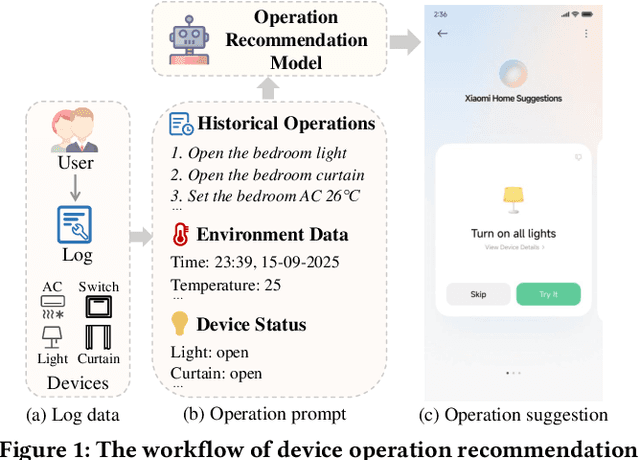
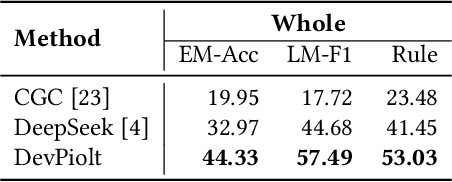
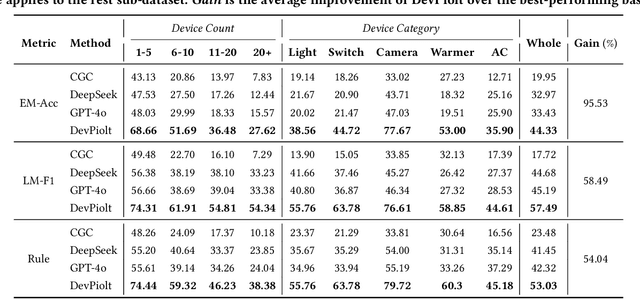
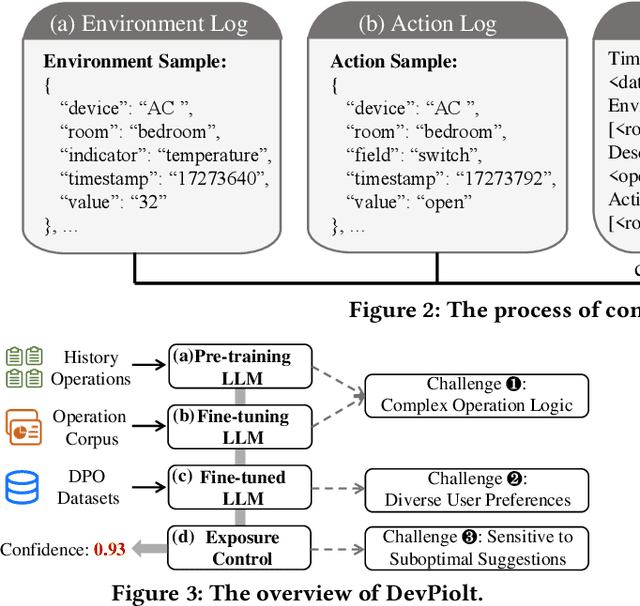
Abstract:Operation recommendation for IoT devices refers to generating personalized device operations for users based on their context, such as historical operations, environment information, and device status. This task is crucial for enhancing user satisfaction and corporate profits. Existing recommendation models struggle with complex operation logic, diverse user preferences, and sensitive to suboptimal suggestions, limiting their applicability to IoT device operations. To address these issues, we propose DevPiolt, a LLM-based recommendation model for IoT device operations. Specifically, we first equip the LLM with fundamental domain knowledge of IoT operations via continual pre-training and multi-task fine-tuning. Then, we employ direct preference optimization to align the fine-tuned LLM with specific user preferences. Finally, we design a confidence-based exposure control mechanism to avoid negative user experiences from low-quality recommendations. Extensive experiments show that DevPiolt significantly outperforms baselines on all datasets, with an average improvement of 69.5% across all metrics. DevPiolt has been practically deployed in Xiaomi Home app for one quarter, providing daily operation recommendations to 255,000 users. Online experiment results indicate a 21.6% increase in unique visitor device coverage and a 29.1% increase in page view acceptance rates.
HyperClick: Advancing Reliable GUI Grounding via Uncertainty Calibration
Oct 31, 2025Abstract:Autonomous Graphical User Interface (GUI) agents rely on accurate GUI grounding, which maps language instructions to on-screen coordinates, to execute user commands. However, current models, whether trained via supervised fine-tuning (SFT) or reinforcement fine-tuning (RFT), lack self-awareness of their capability boundaries, leading to overconfidence and unreliable predictions. We first systematically evaluate probabilistic and verbalized confidence in general and GUI-specific models, revealing a misalignment between confidence and actual accuracy, which is particularly critical in dynamic GUI automation tasks, where single errors can cause task failure. To address this, we propose HyperClick, a novel framework that enhances reliable GUI grounding through uncertainty calibration. HyperClick introduces a dual reward mechanism, combining a binary reward for correct actions with a truncated Gaussian-based spatial confidence modeling, calibrated using the Brier score. This approach jointly optimizes grounding accuracy and confidence reliability, fostering introspective self-criticism. Extensive experiments on seven challenge benchmarks show that HyperClick achieves state-of-the-art performance while providing well-calibrated confidence. By enabling explicit confidence calibration and introspective self-criticism, HyperClick reduces overconfidence and supports more reliable GUI automation.
ACPO: Adaptive Curriculum Policy Optimization for Aligning Vision-Language Models in Complex Reasoning
Oct 01, 2025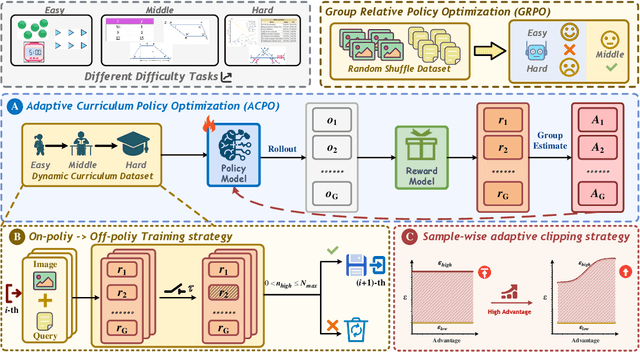


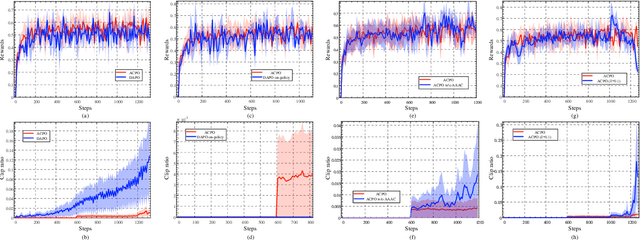
Abstract:Aligning large-scale vision-language models (VLMs) for complex reasoning via reinforcement learning is often hampered by the limitations of existing policy optimization algorithms, such as static training schedules and the rigid, uniform clipping mechanism in Proximal Policy Optimization (PPO). In this work, we introduce Adaptive Curriculum Policy Optimization (ACPO), a novel framework that addresses these challenges through a dual-component adaptive learning strategy. First, ACPO employs a dynamic curriculum that orchestrates a principled transition from a stable, near on-policy exploration phase to an efficient, off-policy exploitation phase by progressively increasing sample reuse. Second, we propose an Advantage-Aware Adaptive Clipping (AAAC) mechanism that replaces the fixed clipping hyperparameter with dynamic, sample-wise bounds modulated by the normalized advantage of each token. This allows for more granular and robust policy updates, enabling larger gradients for high-potential samples while safeguarding against destructive ones. We conduct extensive experiments on a suite of challenging multimodal reasoning benchmarks, including MathVista, LogicVista, and MMMU-Pro. Results demonstrate that ACPO consistently outperforms strong baselines such as DAPO and PAPO, achieving state-of-the-art performance, accelerated convergence, and superior training stability.
BTL-UI: Blink-Think-Link Reasoning Model for GUI Agent
Sep 19, 2025Abstract:In the field of AI-driven human-GUI interaction automation, while rapid advances in multimodal large language models and reinforcement fine-tuning techniques have yielded remarkable progress, a fundamental challenge persists: their interaction logic significantly deviates from natural human-GUI communication patterns. To fill this gap, we propose "Blink-Think-Link" (BTL), a brain-inspired framework for human-GUI interaction that mimics the human cognitive process between users and graphical interfaces. The system decomposes interactions into three biologically plausible phases: (1) Blink - rapid detection and attention to relevant screen areas, analogous to saccadic eye movements; (2) Think - higher-level reasoning and decision-making, mirroring cognitive planning; and (3) Link - generation of executable commands for precise motor control, emulating human action selection mechanisms. Additionally, we introduce two key technical innovations for the BTL framework: (1) Blink Data Generation - an automated annotation pipeline specifically optimized for blink data, and (2) BTL Reward -- the first rule-based reward mechanism that enables reinforcement learning driven by both process and outcome. Building upon this framework, we develop a GUI agent model named BTL-UI, which demonstrates consistent state-of-the-art performance across both static GUI understanding and dynamic interaction tasks in comprehensive benchmarks. These results provide conclusive empirical validation of the framework's efficacy in developing advanced GUI Agents.
Shuffle-R1: Efficient RL framework for Multimodal Large Language Models via Data-centric Dynamic Shuffle
Aug 07, 2025Abstract:Reinforcement learning (RL) has emerged as an effective post-training paradigm for enhancing the reasoning capabilities of multimodal large language model (MLLM). However, current RL pipelines often suffer from training inefficiencies caused by two underexplored issues: Advantage Collapsing, where most advantages in a batch concentrate near zero, and Rollout Silencing, where the proportion of rollouts contributing non-zero gradients diminishes over time. These issues lead to suboptimal gradient updates and hinder long-term learning efficiency. To address these issues, we propose Shuffle-R1, a simple yet principled framework that improves RL fine-tuning efficiency by dynamically restructuring trajectory sampling and batch composition. It introduces (1) Pairwise Trajectory Sampling, which selects high-contrast trajectories with large advantages to improve gradient signal quality, and (2) Advantage-based Trajectory Shuffle, which increases exposure of valuable rollouts through informed batch reshuffling. Experiments across multiple reasoning benchmarks show that our framework consistently outperforms strong RL baselines with minimal overhead. These results highlight the importance of data-centric adaptations for more efficient RL training in MLLM.
CellCLAT: Preserving Topology and Trimming Redundancy in Self-Supervised Cellular Contrastive Learning
May 27, 2025Abstract:Self-supervised topological deep learning (TDL) represents a nascent but underexplored area with significant potential for modeling higher-order interactions in simplicial complexes and cellular complexes to derive representations of unlabeled graphs. Compared to simplicial complexes, cellular complexes exhibit greater expressive power. However, the advancement in self-supervised learning for cellular TDL is largely hindered by two core challenges: \textit{extrinsic structural constraints} inherent to cellular complexes, and intrinsic semantic redundancy in cellular representations. The first challenge highlights that traditional graph augmentation techniques may compromise the integrity of higher-order cellular interactions, while the second underscores that topological redundancy in cellular complexes potentially diminish task-relevant information. To address these issues, we introduce Cellular Complex Contrastive Learning with Adaptive Trimming (CellCLAT), a twofold framework designed to adhere to the combinatorial constraints of cellular complexes while mitigating informational redundancy. Specifically, we propose a parameter perturbation-based augmentation method that injects controlled noise into cellular interactions without altering the underlying cellular structures, thereby preserving cellular topology during contrastive learning. Additionally, a cellular trimming scheduler is employed to mask gradient contributions from task-irrelevant cells through a bi-level meta-learning approach, effectively removing redundant topological elements while maintaining critical higher-order semantics. We provide theoretical justification and empirical validation to demonstrate that CellCLAT achieves substantial improvements over existing self-supervised graph learning methods, marking a significant attempt in this domain.
Distinctive Feature Codec: Adaptive Segmentation for Efficient Speech Representation
May 24, 2025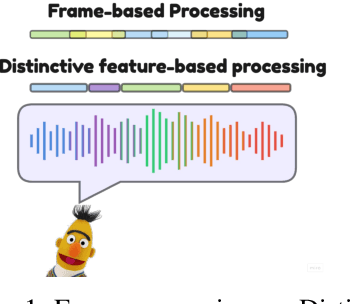
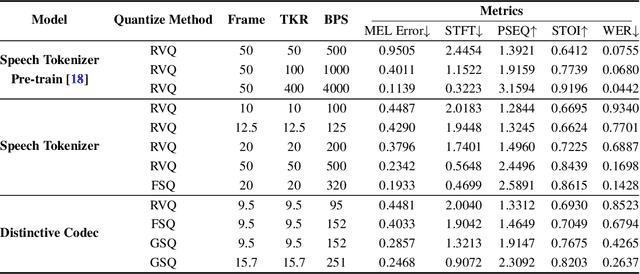
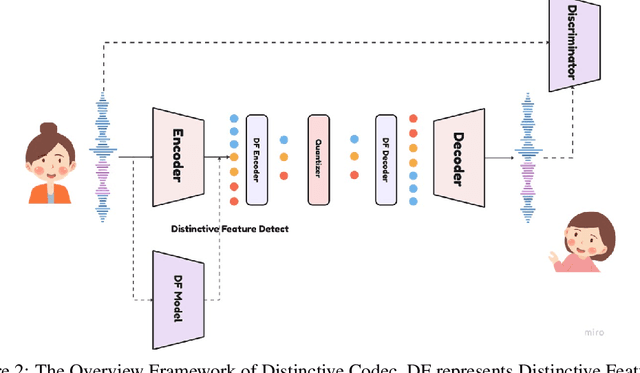

Abstract:The tokenization of speech with neural speech codec models is a crucial aspect of AI systems designed for speech understanding and generation. While text-based systems naturally benefit from token boundaries between discrete symbols, tokenizing continuous speech signals is more complex due to the unpredictable timing of important acoustic variations. Most current neural speech codecs typically address this by using uniform processing at fixed time intervals, which overlooks the varying information density inherent in speech. In this paper, we introduce a distinctive feature-based approach that dynamically allocates tokens based on the perceptual significance of speech content. By learning to identify and prioritize distinctive regions in speech signals, our approach achieves a significantly more efficient speech representation compared with conventional frame-based methods. This work marks the first successful extension of traditional signal processing-based distinctive features into deep learning frameworks. Through rigorous experimentation, we demonstrate the effectiveness of our approach and provide theoretical insights into how aligning segment boundaries with natural acoustic transitions improves codebook utilization. Additionally, we enhance tokenization stability by developing a Group-wise Scalar Quantization approach for variable-length segments. Our distinctive feature-based approach offers a promising alternative to conventional frame-based processing and advances interpretable representation learning in the modern deep learning speech processing framework.
Rethinking the Bias of Foundation Model under Long-tailed Distribution
Jan 27, 2025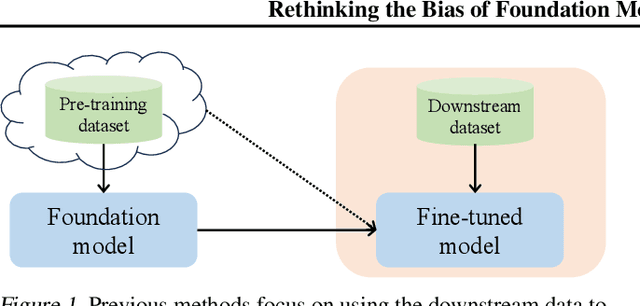
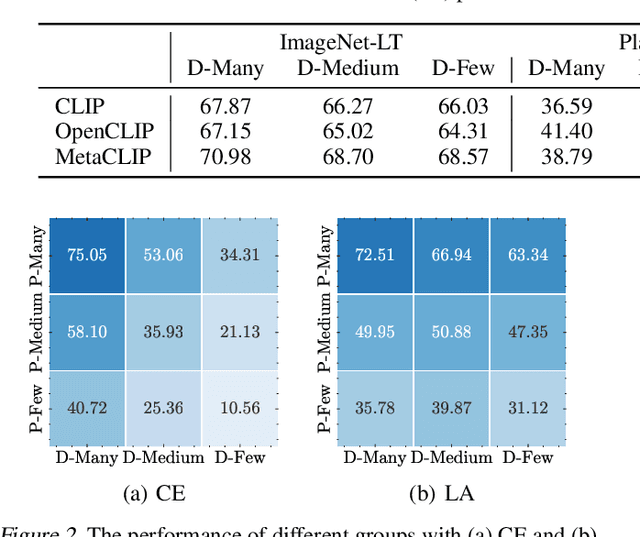
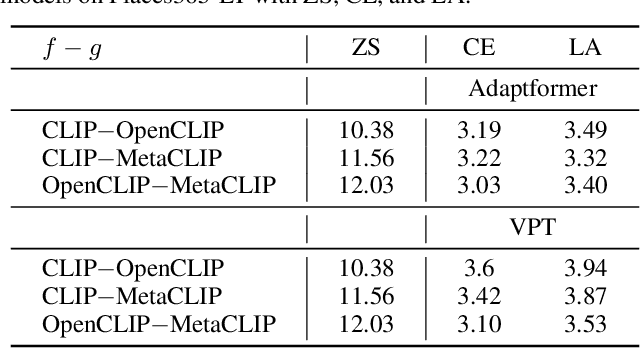

Abstract:Long-tailed learning has garnered increasing attention due to its practical significance. Among the various approaches, the fine-tuning paradigm has gained considerable interest with the advent of foundation models. However, most existing methods primarily focus on leveraging knowledge from these models, overlooking the inherent biases introduced by the imbalanced training data they rely on. In this paper, we examine how such imbalances from pre-training affect long-tailed downstream tasks. Specifically, we find the imbalance biases inherited in foundation models on downstream task as parameter imbalance and data imbalance. During fine-tuning, we observe that parameter imbalance plays a more critical role, while data imbalance can be mitigated using existing re-balancing strategies. Moreover, we find that parameter imbalance cannot be effectively addressed by current re-balancing techniques, such as adjusting the logits, during training, unlike data imbalance. To tackle both imbalances simultaneously, we build our method on causal learning and view the incomplete semantic factor as the confounder, which brings spurious correlations between input samples and labels. To resolve the negative effects of this, we propose a novel backdoor adjustment method that learns the true causal effect between input samples and labels, rather than merely fitting the correlations in the data. Notably, we achieve an average performance increase of about $1.67\%$ on each dataset.
Retrieval-Augmented Generation by Evidence Retroactivity in LLMs
Jan 07, 2025Abstract:Retrieval-augmented generation has gained significant attention due to its ability to integrate relevant external knowledge, enhancing the accuracy and reliability of the LLMs' responses. Most of the existing methods apply a dynamic multiple retrieval-generating process, to address multi-hop complex questions by decomposing them into sub-problems. However, these methods rely on an unidirectional forward reasoning paradigm, where errors from insufficient reasoning steps or inherent flaws in current retrieval systems are irreversible, potentially derailing the entire reasoning chain. For the first time, this work introduces Retroactive Retrieval-Augmented Generation (RetroRAG), a novel framework to build a retroactive reasoning paradigm. RetroRAG revises and updates the evidence, redirecting the reasoning chain to the correct direction. RetroRAG constructs an evidence-collation-discovery framework to search, generate, and refine credible evidence. It synthesizes inferential evidence related to the key entities in the question from the existing source knowledge and formulates search queries to uncover additional information. As new evidence is found, RetroRAG continually updates and organizes this information, enhancing its ability to locate further necessary evidence. Paired with an Answerer to generate and evaluate outputs, RetroRAG is capable of refining its reasoning process iteratively until a reliable answer is obtained. Empirical evaluations show that RetroRAG significantly outperforms existing methods.
 Add to Chrome
Add to Chrome Add to Firefox
Add to Firefox Add to Edge
Add to Edge